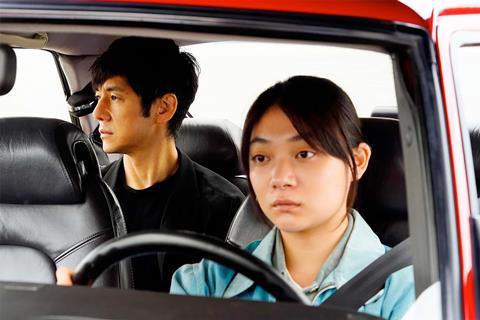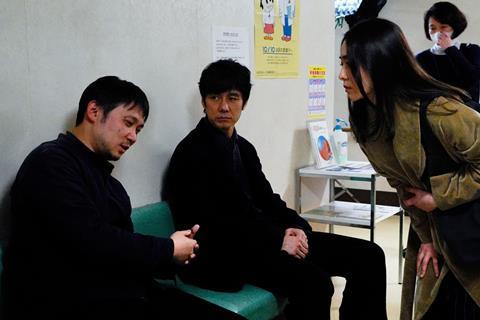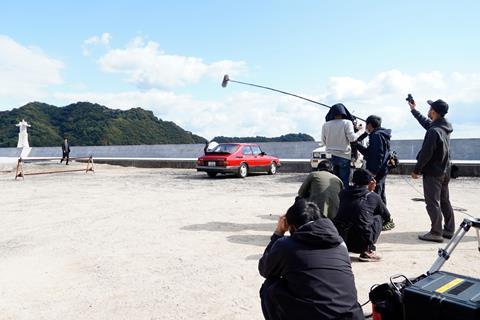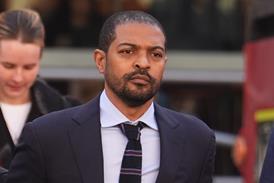
Drive My Car has some serious bona fides: it is based on a story by Haruki Murakami, Japan’s most famous modern author; it stars Hidetoshi Nishijima, one of the country’s biggest stars; and it won the best screenplay award at this year’s Cannes Film Festival. Still, the film is unconventional enough — it is 179 minutes long, for one thing — that when its director Ryusuke Hamaguchi heard it was Japan’s official submission for international feature film at the 2022 Academy Awards, his initial reaction was, “Huh?”
The film stars Nishijima as a theatre actor and director chosen to helm a run of the Chekhov play Uncle Vanya for an art centre in Hiroshima, with a diverse Asian cast all speaking in their own languages. As he interacts with the actors in the play and his driver, a quiet young woman with a mysterious past, he slowly comes to terms with the death of his wife two years prior. Sold by The Match Factory internationally, Drive My Car opened in Japan on August 20. Janus Films and Sideshow begin the US rollout in New York on November 24.
This conversation has been translated from Japanese and edited for length and clarity.
Screen International: How did you two first meet and decide to do this film together?
Ryusuke Hamaguchi: We first met years ago at a holiday party. I remember telling Nishijima that I liked a film he had done, and that he hugged me in response.
Hidetoshi Nishijima: [laughs].
Hamaguchi: I went on to direct a film called Asako I & II, and heard Nishijima-san liked it. We had just started discussions about Drive My Car, and I wondered if I might be able to get him to appear in the film. I’ve enjoyed his performances since I was in my 20s, and I thought he matched the world of Haruki Murakami.
Nishijima-san, what did you like about Asako I & II?
Nishijima: I thought it displayed a real talent for both direction and scriptwriting. It felt like a fusion of fiction and documentary, like it had the power to change filmmaking. I thought, “Wow, he’s able to thrill the audience just by portraying the relationships between these characters.”
Hamaguchi Thank you. I’d like to hug you.
Directing is a major part of the storyline in Drive My Car. What kind of director is Hamaguchi-san?
Nishijima: He is the kind of director that helps you work through your fears. Actors all carry fears, and they have to overcome them to stand in front of the camera. He is thorough in helping actors work through that process in a natural way. He also creates an atmosphere on set where everyone can trust one another to find the right way to create the film.
Nishijima-san plays a theatre director in the film. How did you direct him to direct?
Hamaguchi: I asked him to come to set with the intention of really directing, and he helped create the mood you see in those scenes. On set, we didn’t stop and start; we played the scenes from beginning to end. In that sense, the things happening between the actors were simply captured by the camera. He really did exert his influence, causing the actors to react in a certain way.

Did the experience make you want to try directing?
Nishijima: Not really [laughs]. Not after being in the presence of this master.
Hamaguchi: But it feels to me that you do instinctively influence the performances of your fellow actors on set.
Nishijima: Maybe so. I got the feeling that if we’d had more money and time on Drive My Car, Hamaguchi-san would have actually staged a full performance of Uncle Vanya with me as director.
Hamaguchi: That’s right [laughs].
It’s a very multilingual production, with English, Mandarin, Korean and Korean sign language in addition to Japanese. Did that present any challenges?
Hamaguchi: You need skilled interpreters, and diving into the nuances does take time. But that was the only issue. Otherwise, I didn’t feel any huge differences in the way the cast approached the film. How about you?
Nishijima: Right, all the actors were participating from the same frame of reference, based on the director’s vision. It was a group of actors who all enjoyed the process of diving into the meaning of each line. It brought out a certain richness we couldn’t have achieved if we had all been using the same language.
Were you able to rehearse before shooting?
Hamaguchi: Yes, it’s important for me to have enough time for preparation. There usually isn’t much time for rehearsal on Japanese productions. We did practise blocking on some complicated scenes, but mostly it was just reading the script over and over, like the troupe does in the film.
Nishijima: There was a feeling among us actors that we were putting something on the line, that this film would lead to something bigger in our lives.
Hamaguchi: Yes, it seemed like that by chance, the timing was perfect for everyone. It feels like a piece of each actor’s life was captured on film, so to speak.
So Japanese productions don’t typically have enough rehearsal time?
Nishijima: Personally, I do feel like there’s very little time. Rehearsal helps you discover various things within yourself, which can be hard to do once you’re on set.
Hamaguchi: My only experience doing it in the “typical” way was Asako I & II, but yes, during the shoot, I constantly felt like we didn’t have enough time. If you don’t have time, you need to get lucky to make anything good. Thankfully, I do feel like I got lucky on that film [laughs]. I do hope it becomes more standard in the Japanese industry to establish more time for rehearsal.

What were your impressions of Haruki Murakami before creating the film?
Hamaguchi: There was a time in my 20s when I was obsessed with his novels. I also read his books on creativity, where he talks about things like writing and translation. They were a big influence on me.
Nishijima: I started reading him in my teens. He definitely had a big influence on my generation. I had it somewhere in the back of my head that I might be a good fit for one of his characters, so I’m glad I had the chance to do it, as difficult as it was. However, his lead characters aren’t that cinematic, so I did wonder if there was a way for this character to stay compelling for an entire two‑hour film. Which ultimately became three hours [laughs].
Hamaguchi: In Murakami’s stories, the lead characters don’t move events forward; they are moved forward by events. On the page, you can see their internal dialogue, but you can’t do that on film.
Nishijima: Plus, he’s not the kind of character that remains mysterious. Such characters exist, but in this case, the audience needs to know what he’s thinking. He doesn’t lie, but there are many things he doesn’t say. Finding that balance was tough.
Hamaguchi: Things occur around him, and he reacts. Or, at the least, he watches and listens. In those moments, something real happened within you. Your facial expressions were subtle, but the camera did capture the emotions under the surface. It’s a three-hour film, and you’re in virtually every scene. The power of your performance kept it compelling.
How did you react when you heard Drive My Car would be Japan’s submission to the Academy Awards?
Hamaguchi: “Huh?” I hadn’t even considered it a possibility. For a film like this to be selected to represent Japan, it feels like things have started to change.
Nishijima: Right, I don’t think many films like this have been chosen in the past. If this starts a trend, I think it will help Japan’s film industry grow richer in terms of the kind of films being made.
Hamaguchi: I hope it helps people realise that cinema holds many possibilities.

























No comments yet